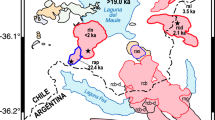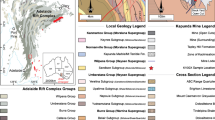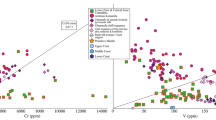Abstract
Mafic microgranular enclaves (MMEs) and Syn-plutonic dykes (SPD) are commonly observed in granitoids and are believed to have a similar period of origin as that of the host. Here the petrographical and mineralogical characteristics of the MMEs and Syn-plutonic dykes from Sircilla granite pluton (SGP), eastern Dharwar craton (EDC), Southern India is presented. The contact relationships of MMEs with the host granite are diffusive or gradational, implying under-cooling and disaggregation of MMEs. Petrographic features such as quartz ocelli, bladed biotite, and acicular apatite grains in mafic enclaves suggest magma mixing/mingling-related processes. Consequently, crystallization temperature and pressure of hornblende and biotite from SPD indicate rapid undercooling and hence suggest their emplacement towards the final stage of pluton evolution. Mineral chemistry studies reveal that the plagioclase in host SGP compositionally varies from An 23–An 27, while the Fe# in biotite vary from 0.47–0.52. The composition of plagioclase and mafic phases in MMEs and the SPDs exhibit variation in compositional range, plagioclase (An 26–An 30), hornblende Mg# (0.42–0.55), and biotite Fe# (0.46–0.54). A decreasing trend in \({{\boldsymbol{f}}_{{{\bf{O}}_{\bf{2}}}}}\) value in MMEs and SPD during progressive crystallization suggest an orogenic tectonic setting of magma formation. Intermediate composition of biotite and plagioclase from MMEs suggest control of magma mixing processes for their formation.
Similar content being viewed by others
References
Abdel-rahman, A.F.M. (1994) Nature of biotites from alkaline, calc-alkaline, and peraluminous magmas. Jour. Petrol., v.35, pp.525–541. doi:https://doi.org/10.1093/petrology/35.2.525
Ahmad, M. (2011) Enclaves in granitoids of north of Jonnagiri schist belt, Kurnool district, Andhra Pradesh: Evidence of magma mixing and mingling. Jour. Geol. Soc. India, v.77, pp.557–573. doi:https://doi.org/10.1007/s12594-011-0052-1
Anettsungla, Rino, V., Kumar, S. (2018) Redox Condition, Nature and Tectonomagmatic Environment of Granitoids and Granite gneisses from the Karbi Anglong Hills, Northeast India: Constraints from Magnetic Susceptibility and Biotite Geochemistry. Jour. Geol. Soc. India, v.91, pp.601–612. doi:https://doi.org/10.1007/s12594-018-0911-0
Arvin, M., Dargahi, S., Babaei, A.A. (2004) Mafic microgranular enclave swarms in the Chenar granitoid stock, NW of Kerman, Iran: Evidence for magma mingling. Jour. Asian Earth Sci., v.24, pp.105–113.
Azadbakht, Z., Lentz, D.R., McFarlane, C.R.M., Whalen, J.B. (2020) Using magmatic biotite chemistry to differentiate barren and mineralized Silurian-Devonian granitoids of New Brunswick, Canada. Contrib. Mineral. Petrol., v.175. doi:https://doi.org/10.1007/s00410-020-01703-2
Barbarin, B. (2005) Mafic magmatic enclaves and mafic rocks associated with some granitoids of the central Sierra Nevada batholith, California: Nature, origin, and relations with the hosts. Lithos., v.80, pp.155–177. doi:https://doi.org/10.1016/j.lithos.2004.05.010
Barbarin Bernard, Didier, J. (1992) Genesis and evolution of mafic microgranular enclaves through various types of interaction between coexisting felsic and mafic magmas. Trans. Roy. Soc. Edinb. Earth Sci., v.83, pp.145–153. doi:https://doi.org/10.1017/S0263593300007835
Baxter, S. (2002) Field and petrographic evidence for magma mixing and mingling in Granitoids: Examples from the Galway Granite, Connemara. Mineral. Petrol., v.76, pp.63–74. doi:https://doi.org/10.1007/s00710-001-0178-8
Bussy, F. (1990) The rapakivi texture of feldspars in a plutonic mixing environment: A dissolution recrystallization process? Geol. Jour., v.25, pp.319–324. doi:https://doi.org/10.1002/gj.3350250314
Cao, M.J., Qin, K.Z., Li, G.M. (2016) Genesis of ilmenite-series I-type granitoids at the Baogutu reduced porphyry Cu deposit, western Junggar, NW-China. Lithos, v.246–247, pp.13–30. doi:https://doi.org/10.1016/j.lithos.2015.12.019
Chardon, D., Jayananda, M., Peucat, J.J. (2011) Lateral constrictional flow of hot orogenic crust: Insights from the Neoarchean of south India, geological and geophysical implications for orogenic plateaux. Geochemistry, Geophys Geosystems., v.12. doi:https://doi.org/10.1029/2010GC003398
Collins, W.J., Richards, S.R., Healy, B.E., Ellison, P.I. (2000) Origin of heterogenous mafic enclaves by two-stage hybridisation in magma conduits (dykes) below in and granitic magma chambers. Trans. Roy. Soc. Edinburgh, Earth Sci., v.91, pp.27–45. doi:https://doi.org/10.1017/s0263593300007276
Dey, S., Pal, S., Balakrishnan, S. (2018) Both plume and arc: Origin of Neoarchaean crust as recorded in Veligallu greenstone belt, Dharwar craton, India. Precambrian Res., v.314, pp.41–61. doi:https://doi.org/10.1016/j.precamres.2018.04.019
Elangovan, R., Krishna, K., Vishwakarma, N. (2017) Interaction of coeval felsic and mafic magmas from the Kanker Granite, Pithora region, Bastar Craton, central India. Jour Earth Syst. Sci., v.126, pp.1–15. doi:https://doi.org/10.1007/s12040-017-0886-z
Foster, M.D. (1960) Interpretation of the composition of trioctahedral micas. USGS Prof Pap., v.354, pp.11–48
Guitreau, M., Mukasa, S.B., Loudin, L., Krishnan, S. (2017) New constraints on the early formation of the Western Dharwar Craton (India) from igneous zircon U-Pb and Lu-Hf isotopes. Precambrian Res., v.302, pp.33–49
Henry, D.J., Guidotti, C.V., Thomson, J.A. (2005) The Ti-saturation surface for low-to-medium pressure metapelitic biotites: Implications for geothermometry and Ti-substitution mechanisms. Amer. Mineral., v.90, v.316–328. doi:https://doi.org/10.2138/am.2005.1498
Hibbard, M.J. (1991) Textural anatomy of twelve magma-mixed granitoid systems. Enclaves Granite Petrol. Dev. Pet., v.32, pp.431–444
Hibbard, M.J. (1981) The magma mixing origin of mantled feldspars. Contrib to Mineral Petrol., v.76, pp.158–170. doi:https://doi.org/10.1007/BF00371956
Hietanen, A. (1974) Amphibole pairs, epidote minerals, chlorite, and plagioclase in metamorphic rocks, northern Sierra Nevada, California. Amer. Mineral., v.59, pp.22–40.
Jayananda, M., Gireesh, R.V., Sekhamo, K.U., Miyazaki, T. (2014) Coeval felsic and Mafic Magmas in neoarchean calc-alkaline magmatic arcs, Dharwar craton, Southern India: Field and petrographic evidence from mafic to Hybrid magmatic enclaves and synplutonic Mafic dykes. Jour. Geol. Soc. India, v.84, pp.5–28. doi:https://doi.org/10.1007/s12594-014-0106-2
Jayananda, M, Guitreau, M., Tarun Thomas, T. (2019) Geochronology and geochemistry of Meso- to Neoarchean magmatic epidote-bearing potassic granites, western Dharwar Craton (Bellur-Nagamangala-Pandavpura corridor), southern India: implications for the successive stages of crustal reworking and cratonizatio. Geol. Soc. London, Spec. Publ., SP489-2018-125. doi:https://doi.org/10.1144/sp489-2018-125
Jayananda, M., Miyazaki, T., Gireesh, R.V. (2009) Synplutonic mafic dykes from late archaean granitoids in the Eastern Dharwar Craton, southern India. Jour. Geol. Soc. India, v.73, pp.117–130. doi:https://doi.org/10.1007/s12594-009-0007-y
Jeen, M.J., Kim, J.S., Lee, J. (2002) Study on the origin of rapakivi texture in Bangeojin granite. Jour. Petrol. Soc. Korea, v.11, pp.30–48
Kocak, K., Zedef, V., Kansun, G. (2011) Magma mixing/mingling in the Eocene Horoz (Nigde) granitoids, Central southern Turkey: Evidence from mafic microgranular enclaves. Mineral. Petrol., v.103, pp.149–167. doi:https://doi.org/10.1007/s00710-011-0165-7
Kumar, S. (1995) Microstructural evidence of magma quenching inferred from microgranular enclave hosted in Hodrusa granodiorite, western Carpathians. Geol. Carpathica, v.46, pp.379–382
Leake, B.E., Woolley, A.R., Arps, C.E.S. (1997) Nomenclature of amphiboles: Report of the subcommittee on amphiboles of the international mineralogical association, commission on new minerals and mineral names. Can. Mineral., v.35, pp.219–246
Leake, B.E., Woolley, A.R., Birch, W.D. (2004) Nomenclature of amphiboles: Additions and revisions to the International Mineralogical Association’s amphibole nomenclature. Amer. Mineral., v.89, pp.883–887. doi:https://doi.org/10.1180/0026461046810182
Maya, J.M., Bhutani, R., Balakrishnan, S., Rajee Sandhya, S. (2017) Petrogenesis of 3.15 Ga old Banasandra komatiites from the Dharwar craton, India: Implications for early mantle heterogeneity. Geosci Front., v.8, pp.467–481. doi:https://doi.org/10.1016/j.gsf.2016.03.007
Meshram, T., Dora, M.L., Baswani, S.R. (2021) Petrogenesis and U-Pb geochronology of charnockites flanking the Pranhita Godavari rift in peninsular India-link between the Bastar and Eastern Dharwar Cratons. Gondwana Res., v.92, pp.113–132. doi:https://doi.org/10.1016/j.gr.2020.12.024
Nachit, H., Ibhi, A., Abia, E.H., Ben Ohoud, M. (2005) Discrimation entre biotites magmatiques primaires, biotites rééquilibrées et biotites néoformées. Comptes Rendus — Geosci., v.337, pp.1415–1420. doi:https://doi.org/10.1016/j.crte.2005.09.002
Perugini, D., Poli, G. (2012) The mixing of magmas in plutonic and volcanic environments: Analogies and differences. Lithos, v.153, pp.261–277
Perugini, D., Poli, G., Christofides, G., Eleftheriadis, G. (2003) Magma mixing in the Sithonia Plutonic Complex, Greece: Evidence from mafic microgranular enclaves. Mineral. Petrol., v.78, pp.173–200. doi:https://doi.org/10.1007/s00710-002-0225-0
Peucat, J.J., Jayananda, M., Chardon, D. (2013) The lower crust of the Dharwar Craton, Southern India: Patchwork of Archean granulitic domains. Precambrian Res., v.227, pp.4–28. doi:https://doi.org/10.1016/j.precamres.2012.06.009
Rajesham, T., Rao, Y.J.B., Murti, K.S. (1993) The Karimnagar granulite terrane — a new sapphirine bearing granulite province, south India. Jour. Geol. Soc. India, v.41, pp.51–59.
Ramakrishnan, M., Vaidyanadhan, R. (2008) Geology of India, v.1. Geological Society of India, Bangalore.
Ridolfi, F., Renzulli, A., Puerini, M. (2010) Stability and chemical equilibrium of amphibole in calc-alkaline magmas: An overview, new thermobarometric formulations and application to subduction-related volcanoes. Contrib. Mineral. Petrol., v.160, pp.45–66. doi:https://doi.org/10.1007/s00410-009-0465-7
Sarbajna, C., Bose, S., Rajagopalan, V. (2013) U-Cr-rich high Mg-Al granulites from Karimnagar Granulite Belt, India: Implications for Neoarchean-Paleoproterozoic events in southern India. Mineral. Petrol., v.107, pp.553–571. doi:https://doi.org/10.1007/s00710-012-0242-6
Schmidt, M.W. (1992) Amphibole composition in tonalite as a function of pressure: an experimental calibration of the Al-in-hornblende barometer. Contrib. Mineral. Petrol., v.110, pp.304–310. doi:https://doi.org/10.1007/BF00310745
Sial, A.N., Ferreira, V.P., Fallick, A.E., Jerônim, O. M. (1998) Amphibole-rich clots in calc-alkalic granitoids in the Borborema province, northeastern Brazil. Jour. South Amer Earth Sci., v.11, pp.457–471. doi:https://doi.org/10.1016/S0895-9811(98)00034-0
Streckeisen, A. (1976) To each plutonic rock its proper name. Earth Sci. Rev., v.12, pp.1–33. doi:https://doi.org/10.1016/0012-8252(76)90052-0
Uchida, E., Endo, S., Makino, M. (2007) Relationship between solidification depth of granitic rocks and formation of hydrothermal ore deposits. Resour. Geol., v.57, pp.47–56. doi:https://doi.org/10.1111/j.1751-3928.2006.00004.x
Vernon, R.H. (1990) Crystallization and hybridism in microgranitoid enclave magmas: microstructural evidence. Jour. Geophys. Res., v.95, pp.849–859. doi:https://doi.org/10.1029/jb095ib11p17849
Vernon, R.H. (1991) Interpretation of microstructures of microgranitoid enclaves. In: Didier, J., Barbarin, B. (Eds.), Enclaves and Granite Petrology, Developments in Petrology, pp.277–291.
Yang, Z., Fu, Y. (2020) Distinct evolution history of magmatic oxygen fugacity and its control on associated porphyry Cu deposits under subduction and collisional settings. Geol. Jour., v.55, pp.7101–7113. doi:https://doi.org/10.1002/gj.3865
Acknowledgments
The authors are thankful to Director; CSIR-NGRI for permitting to publish this work. This work forms part of the Ph.D. thesis of the first author. First author acknowledges the UGC-RGNF Fellowship to carry out this work. Authors thank to Ms. S. Manju, Senior Scientist, CSIR-NGRI for help with EPMA analysis. Finally, we thank the anonymous reviewer for providing generous scientific comments on an earlier version which greatly improved the paper.
Author information
Authors and Affiliations
Corresponding author
Electronic supplementary material
Rights and permissions
About this article
Cite this article
Ashok, C., Babu, E.V.S.S.K., Dash, S. et al. Redox Condition and Mineralogical Evidence of the Magma Mixing Origin of the Mafic Microgranular Enclaves (MMEs) from Sircilla Granite Pluton (SGP), Eastern Dharwar Craton (EDC), India. J Geol Soc India 98, 1237–1243 (2022). https://doi.org/10.1007/s12594-022-2158-z
Received:
Accepted:
Published:
Issue Date:
DOI: https://doi.org/10.1007/s12594-022-2158-z




